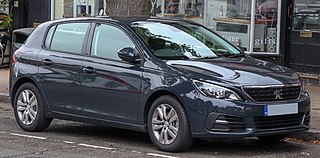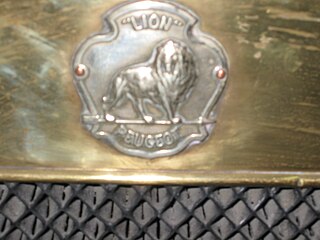
Citroën is a French brand of automobiles owned by Stellantis.

Peugeot is a French brand of automobiles owned by Stellantis.

Panhard was a French motor vehicle manufacturer that began as one of the first makers of automobiles. It was a manufacturer of light tactical and military vehicles. Its final incarnation, now owned by Renault Trucks Defense, was formed by the acquisition of Panhard by Auverland in 2005, and then by Renault in 2012. In 2018 Renault Trucks Defense, ACMAT and Panhard combined under a single brand, Arquus.

De Dion-Bouton was a French automobile manufacturer and railcar manufacturer operating from 1883 to 1953. The company was founded by the Marquis Jules-Albert de Dion, Georges Bouton, and Bouton's brother-in-law Charles Trépardoux.

The PSA Group, legally known as Peugeot S.A., was a French multinational automotive manufacturing company which produced automobiles and motorcycles under the Peugeot, Citroën, DS, Opel and Vauxhall brands. On 18 December 2019, PSA and Fiat Chrysler Automobiles announced that they had agreed to the terms of a binding $50 billion merger. On 16 July 2020, both companies announced the new name for their merged operations, Stellantis. The deal closed on 16 January 2021.
Dongfeng Peugeot-Citroën, formerly Dongfeng Peugeot-Citroën Automobile Co., Ltd. (DPCA) from 1992 to 2021, is an equally owned Chinese joint venture between the automobile manufacturers Dongfeng Motor Corporation and Stellantis. Based in Wuhan, capital of Hubei province, it manufactures Peugeot and Citroën models for sale in China.

Executive car is a British term for a large car which is equivalent to the European E-segment and American full-size classifications. Executive cars are larger than compact executive cars, and smaller than luxury saloons / full-size luxury sedans.

The Peugeot 308 is a small family car produced by French automaker Peugeot. It was unveiled in June 2007, and launched in September 2007. The 308 replaced the 307, and positioned below the 508 and above the smallest 208.

GAC Group is a Chinese automobile maker headquartered in Guangzhou, Guangdong, and a subsidiary of Guangzhou Automobile Industry Group.

A car is a wheeled motor vehicle used for transportation. Most definitions of cars say that they run primarily on roads, seat one to eight people, have four wheels, and mainly transport people rather than goods.

The Mitsubishi i-MiEV is a five-door hatchback electric car produced in the 2010s by Mitsubishi Motors, and is the electric version of the Mitsubishi i. Rebadged variants of the i-MiEV are also sold in Europe by PSA Peugeot Citroën (PSA) as the Peugeot iOn and Citroën C-Zero. The i-MiEV was the world's first modern highway-capable mass production electric car.
This article provides an overview of the automotive industry in countries around the world.

The automotive industry in Japan is one of the most prominent and largest industries in the world. Japan has been in the top three of the countries with most cars manufactured since the 1960s, surpassing Germany. The automotive industry in Japan rapidly increased from the 1970s to the 1990s and in the 1980s and 1990s, overtook the U.S. as the production leader with up to 13 million cars per year manufactured and significant exports. After massive ramp-up by China in the 2000s and fluctuating U.S. output, Japan is currently the third largest automotive producer in the world with an annual production of 9.9 million automobiles in 2012. Japanese investments helped grow the auto industry in many countries throughout the last few decades.

Lion-Peugeot is a formerly independent French auto-maker. It is the name under which in 1906 Robert Peugeot and his two brothers, independently of the established Peugeot car business, began to produce automobiles at Beaulieu near Valentigney.
France was a pioneer in the automotive industry and is the 11th-largest automobile manufacturer in the world by 2015 unit production and the third-largest in Europe. It had consistently been the 4th-largest from the end of World War II up to 2000.
The Paris–Marseille–Paris race was the first competitive 'city to city' motor race originating in Paris, where the first car across the line was the winner, prior events having selected the winner by various forms of classification and judging. The race was won by Émile Mayade who completed the ten-day, 1,710 km, event over unsurfaced roads in 67 hours driving a Panhard et Levassor.
Auto racing began in the mid-19th century. It became an organized sport, which has grown in popularity ever since.

Automotive industry in Vietnam is a fast growing sector, mainly reliant on domestic sales. All currently produced models are designed abroad by foreign brands, and many rely on knock-down kit production. Due to high import taxes on automobiles, the Vietnamese government protects domestic manufacturing. Although Vietnam is a member of the ASEAN Free Trade Area, automobile imports fall under an exception. Since January 1, 2018, the 30% import tax has been discontinued as part of ASEAN agreements. Currently, the Vietnamese motor industry is not deemed competitive enough to make exports feasible. As of April 2018, 85% of car sales in Vietnam were produced domestically from CKD kits.













